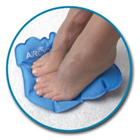If you have a balance problem that is not tied to illness, medication or some other specific cause, simple exercises can help preserve, and perhaps improve, your balance.
Avoid Perils of Freefall
"You put in three or four days a week of cardiovascular work, squeeze in two sessions of strength training, even find time to do some stretching. Isn't that enough to keep an ageing body healthy?"
"Sorry, it isn't," says a recent article in the Dominion Post. "Everyone, from gerontologists to personal trainers, says you need to work on balance as well. Studies show that balance declines with age and the results of that decline can be catastrophic."
"One out of three people aged 65 and older falls each year. Falls are the top cause of injury death among that population. Men are more likely than women to be killed in falls. But women suffer non fatal injuries or broken bones much more frequently. Women are almost three times more likely to break a hip, one of the most debilitating results of falls among older people."
Your ability to stay upright and move through space is determined by a complex combination of muscle strength, visual inputs, the inner ear and the work of specialized receptors in the nerves of your joints, muscles, ligaments and tendons that orientate you in relation to other objects. The cortex of your brain takes the information from these sources and orchestrates your response.
"But ageing dulls these senses. The functioning of those receptors declines and the processing of the information over neural pathways slows."
So what can you do? You don't often think of working to improve your balance but you should, experts say.
Simple exercises can help preserve and perhaps improve your balance. Some examples are listed here.
1) Stand on one foot for 10 seconds. Do ten repetitions. Then change to the other foot. You can do this while waiting for the bus or standing in a queue, waiting for the kettle to boil, while talking on the phone or even while watching TV. At first you might want to hold a wall or a chair.
2) Heel – toe walk. Take twenty steps while looking straight ahead. Think of walking along a narrow path.
3) Leg strengthening exercises.
A) For active, energetic people there are many activities and exercises to choose from, including hiking, cycling and dancing to name a few. Tai Chi and yoga classes can be useful for both leg strengthening and balancing.
B) For less mobile people and those who never quite get around to more vigorous activities, there are options available. In some centres there is a "Stay on your Feet" programme delivered in the home by trained volunteers and supervised by a registered nurse. Presbyterian Support also runs a volunteer based exercise programme as part of a wider Falls Prevention programme.
C) Another alternative, whether you are still active or less mobile, is a soft, simple exerciser called an Aircycle which you can use while you sit in front of TV. The Aircycle works your leg muscles and with frequent use as you sit, you will quickly notice an improvement in the strength of your calf and thigh muscles. Being stronger in the legs you will be more steady on your feet, helping you to avoid falling and losing your independence.
For more information on the Aircycle call 04 569 5013 or visit www.aircycle.co.nz.
Find the AirCycle in the GrownUps Shop here.
*Quotes from The Dominion Post July 2013.










Join the Discussion
Type out your comment here:
You must be logged in to post a comment.